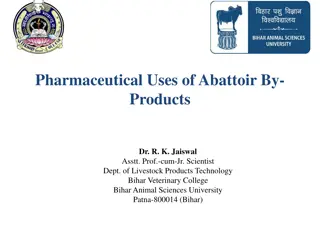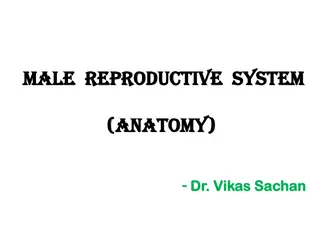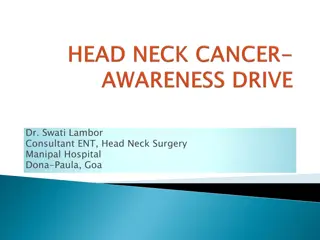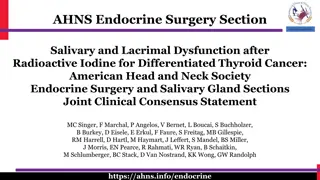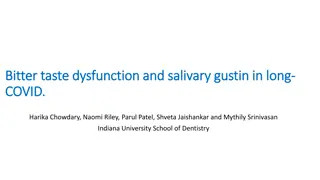Understanding the Digestive System Processes
The digestive system is responsible for the breakdown, absorption, and elimination of food. It involves processes such as ingestion, propulsion, mechanical and chemical digestion, absorption, and defecation. Starting from the mouth with salivary glands and oral cavity, it progresses through the esop
3 views • 38 slides
SALIVARY GLAND IMAGING
Salivary gland imaging plays a crucial role in diagnosing and monitoring diseases of the major salivary glands, including the parotid, submandibular, and sublingual glands. Different imaging techniques such as computed tomography, MRI, and ultrasound are used to visualize these glands and aid in dif
1 views • 12 slides
How is Sialoendoscopy Helpful in Curing Salivary Stones? - Dr Sharad ENT
Delve into the examination of sialoendoscopy as a minimally invasive procedure for addressing salivary stones. Gain insights into its potential advantages, associated risks, and comparative analysis with other available treatments.\n\nFor More Visit- \/\/ \/salivary-stones-is-sialoendoscopy-really-t
1 views • 9 slides
Understanding the Digestive System: Medical Terminology Overview
The digestive system, comprising the gastrointestinal tract (GIT) and accessory organs, plays a vital role in digestion. From the upper GI tract (oral cavity, esophagus, stomach) to the lower GI tract (small and large intestines), each part has specific functions. Understanding salivary glands and c
0 views • 18 slides
Affections of Salivary Glands in Veterinary Surgery: Overview and Treatment
Salivary gland affections in animals, particularly dogs, are discussed, highlighting the main pairs of salivary glands and their locations. The content covers details on the parotid, mandibular, sublingual, and zygomatic glands, along with their respective ducts. Information on congenital and acquir
0 views • 28 slides
Understanding Glandular Specialized Epithelium and Glands
Glandular specialized epithelium forms a class of epithelial tissues with specific functions and structures, composed of cuboidal, columnar, and ciliated columnar epithelial cells. These tissues contain gland cells that are secretary in nature, with zymogen granules in the cytoplasm. Glands are spec
1 views • 35 slides
Understanding Glandular Epithelium and Secretory Cells
Glandular epithelium consists of epithelial cells specialized in producing and secreting various macromolecules, found in glands throughout the body. These secretory cells can synthesize proteins, lipids, and carbohydrates, with different types of glands such as exocrine and endocrine glands. The se
0 views • 13 slides
Pharmaceutical Uses of Abattoir By-Products in Medicine
Animal glands play a significant role in medicine due to their healing properties. Glands contain digestive enzymes and hormones that are extracted for pharmaceutical purposes. The utilization of glands in India has been neglected but holds economic potential in major cities. Proper collection and p
2 views • 22 slides
Understanding Diseases of the Hair, Wool, Follicles, and Skin Glands
Diseases of the Hair, Wool, Follicles, and Skin Glands covers various conditions like alopecia, hypotrichosis, and the failure of follicles to develop or produce fibers. It discusses causes, pathogenesis, clinical findings, and treatments related to hair and skin issues. The content delves into cong
0 views • 18 slides
Demonstration of Salivary Amylase Enzyme Action in B.Sc. Practical
Salivary amylase, an enzyme found in saliva, partially hydrolyzes starch into maltose. This practical involves observing the action of salivary amylase on starch, demonstrating how starch is broken down into glucose and maltose. The procedure includes preparing solutions, collecting saliva, mixing w
0 views • 5 slides
Understanding the Secretory Functions of the Alimentary Tract
This content delves into the secretory functions of the alimentary tract, focusing on the secretion of saliva and the role of mastication. It covers the anatomy of salivary glands, composition of saliva, control of secretion by the nervous system, and the functions of saliva in lubrication, protecti
1 views • 30 slides
Understanding Parathyroid Glands and Calcium Regulation
Parathyroid glands play a crucial role in maintaining the body's calcium levels within a narrow range to support the proper functioning of the nervous and muscular systems. Parathyroid hormone (PTH) regulates calcium concentration in the blood, impacting bone health and other physiological functions
4 views • 18 slides
Overview of Human Endocrine System in Life Sciences Presentation
This content provides a detailed examination guideline for understanding the human endocrine system in the field of life sciences. It covers essential topics such as the difference between endocrine and exocrine glands, hormone functions, gland locations with functions, and key terminology related t
1 views • 17 slides
Thyroid and Parathyroid Glands Histological Structure Overview
This detailed histological study covers the structure and function of the thyroid and parathyroid glands. It includes information on the stroma, parenchyma, follicular cells, parafollicular cells, and the microscopic structure of the parathyroid gland. The article also delves into the functions of v
0 views • 8 slides
Understanding the Hydrolytic Activity of Salivary Amylase on Starch
Enzymes play a crucial role in catalyzing chemical reactions in the human body. This experiment focuses on the hydrolytic activity of salivary amylase on starch, breaking down polysaccharides into intermediate products like maltose. The mechanism of amylase action, types of amylase, and the assay me
0 views • 16 slides
Understanding Glands: Endocrine and Exocrine Systems
Glands play a crucial role in the body by producing and releasing substances for specific functions. Endocrine glands release hormones directly into the bloodstream, while exocrine glands secrete substances through ducts onto bodily surfaces. Different types of exocrine glands, such as sweat glands,
3 views • 22 slides
Demonstration of Salivary Enzyme Amylase Action in B.Sc. Practical
Salivary enzyme amylase, also known as ptyalin, plays a crucial role in breaking down starch and glycogen into maltose. This practical session in the Zoology department explores the action of salivary enzyme amylase at a temperature of 37°C and pH of 6.6. By conducting experiments with starch, iodi
0 views • 8 slides
Utilization of Glands and Biochemicals in Meat Science Research
Glands play a crucial role in meat science research, with various organs such as pancreas, adrenal glands, and parathyroid gland providing valuable biochemicals like insulin, thyroxine, and corticosteroids. The extraction methods and applications of these glands in food science and medicine are deta
0 views • 25 slides
Understanding Polytene Chromosomes in Botany: Study Material for B.Sc. Part II Hons. Paper IV
Polytene chromosomes, giant chromosomes found in salivary glands of insects like fruit flies, exhibit unique banding patterns consisting of bands and interbands. Researchers like Balbiani have studied these chromosomes, noting over 5000 bands in Drosophila. The uncoiling of chromomeres in bands form
0 views • 14 slides
Exploring the Endocrine System as the Third Temple of our Body
Delve into the fascinating connections between the endocrine system and biblical references, likening its functions to the operations of the Tribe of Asher. Discover how this system, composed of glands producing hormones, impacts growth, metabolism, and sexual development. Explore the intricate netw
0 views • 24 slides
Understanding the Secretions of the Gastrointestinal Tract (GIT)
The gastrointestinal tract (GIT) is responsible for digestion, absorption, and secretion through various glands along the alimentary canal. Secretions are stimulated by factors like direct contact, nervous system activation, and hormonal regulation. Hormones released in response to food presence hel
0 views • 7 slides
Understanding the Male Reproductive System: An Overview by Dr. Vikas Sachan
Exploring the male reproductive system anatomy, including the testes, scrotum, reproductive ducts, and accessory sex glands, highlighting the production of sperm and male sex hormones. The role of primary and secondary sex organs, such as the epididymis, vas deferens, urethra, and penis, along with
0 views • 52 slides
Comprehensive Overview of Head and Neck Cancer by Dr. Swati Lambor, ENT Consultant
Cancer of the head and neck region poses a significant threat, with various types of tumors affecting areas like the nasal cavity, paranasal sinuses, mouth, larynx, salivary glands, and thyroid. Dr. Swati Lambor, a skilled ENT consultant at Manipal Hospital in Goa, sheds light on the causes, progres
0 views • 72 slides
Understanding the Anatomy of the Oral Cavity
The oral cavity extends from the lips to the hard and soft palate and houses various structures like the tongue, buccal mucosa, floor of the mouth, hard palate, gingiva, and lips. This detailed overview covers the different regions of the tongue, mucosal linings, salivary glands, and palatal structu
0 views • 27 slides
Various Stomach Anatomy Slides of Different Animal Species
Explore a series of detailed histological slides showcasing the stomach anatomy of different animal species including cats, rabbits, dogs, pigs, sheep, and goats. The images highlight key features such as gastric pits, mucosal layers, chief and parietal cells, proper gastric glands, cardiac and pylo
0 views • 29 slides
Overview of Gastrointestinal Secretions and Structural Considerations
In this informative presentation by Assistant Professor Dr. Emre Hamurtekin, the focus is on gastrointestinal secretions including salivary, gastric, pancreatic, biliary, and intestinal fluids. Structural considerations such as the surface area for absorption, sphincters, villi, and crypts are discu
0 views • 33 slides
Understanding Male Reproductive Anatomy and Function
Explore the intricate male reproductive system from meiosis to accessory glands, learning about the purpose and location of processes like meiosis, sperm production in the testes, and the functions of structures such as the epididymis, vas deferens, urethra, and accessory glands in semen production
2 views • 23 slides
Structure of Gastric Mucosa in Glandular Stomach
The glandular stomach features laminae epithelialis lined with simple columnar epithelium, leading to differentiation into gastric pits and glands. The laminae propria houses tubular gastric glands, while the laminae muscularis mucosa is composed of smooth muscles. Different regions exhibit distinct
0 views • 14 slides
Understanding Blepharitis: Anatomy, Structure, and Glands of Eyelids
Blepharitis is a common eye condition characterized by inflammation of the eyelids. This article dives into the anatomy of eyelids, including their structure and the various glands present. It explains the position of eyelids, the canthi, and the palpebral aperture. Additionally, it discusses the Me
0 views • 31 slides
Understanding the Endocrine System: Key Concepts and Functions
The endocrine system, consisting of glands that release hormones into the bloodstream, plays a crucial role in regulating various body processes like metabolism, growth, reproduction, and stress response. Key glands include the pituitary, thyroid, pancreas, adrenal, ovaries, and testes, each produci
0 views • 34 slides
Comprehensive Overview of Salivary Gland Diseases and Management
Salivary gland diseases encompass various conditions affecting the salivary glands, including developmental abnormalities, inflammatory and non-inflammatory enlargement, cysts, tumors, and dysfunction. Investigations such as plain films, sialography, MRI, and biopsies are essential for diagnosis. Si
0 views • 49 slides
Understanding How Hormones Interact: The Endocrine System
The endocrine system comprises glands that release hormones into the bloodstream, influencing various bodily functions. Key glands include the pituitary, pineal, thyroid, pancreas, gonads, and adrenal glands, each playing a crucial role in regulating metabolism, growth, stress response, and reproduc
0 views • 5 slides
Understanding Saliva and Salivary Glands in Digestion Process
Saliva is a watery secretion produced by salivary glands in the mouth, aiding in food digestion, swallowing, and moistening food. Human salivary glands include parotid, submaxillary, and sublingual glands, each producing different types of secretions. The glands are made up of secretory acini and du
0 views • 29 slides
Salivary and Lacrimal Dysfunction after Radioactive Iodine Treatment
Radioactive iodine (RAI) is commonly used in treating differentiated thyroid cancer but can lead to salivary and lacrimal dysfunction. This joint clinical consensus statement by the American Head and Neck Society Endocrine Surgery and Salivary Gland Sections highlights the importance of understandin
0 views • 20 slides
Overview of Salivary Glands Structure
Salivary glands play a crucial role in the production and secretion of saliva, aiding in digestion and oral health. The parotid gland is a compound tubuloacinar gland with serous characteristics, while the sublingual gland is a seromucous type. Minor salivary glands, found in carnivores, vary in com
0 views • 16 slides
Overview of Salivary Gland Tumors and Diseases
Salivary gland diseases, including tumors, can affect both major and minor glands. These tumors may be benign or malignant, with common benign tumors like pleomorphic adenoma. Clinical features of salivary gland tumors vary, with slow-growing benign tumors being more common. Pleomorphic adenoma is p
0 views • 27 slides
Early Life Intervention Diminishes Sjögren's Syndrome Manifestations in Mice
Early life intervention has been shown to reduce the clinical manifestations of Sjögren's syndrome in NOD.H-2h4 mice, which mimic key features of the human autoimmune disease. The syndrome is characterized by salivary gland autoantibodies, ectopic lymphoid follicles, reduced salivary and tear flow,
0 views • 19 slides
Understanding Virus Transmission via Vectors
Viruses must be transmitted to new hosts for their survival. This transmission occurs through vectors like arthropods, which acquire and transmit viruses during feeding. The mechanism involves viruses attaching to the vectors' mouthparts or entering their circulatory system to reach salivary glands
0 views • 14 slides
Salivary Gustin and Taste Dysfunction in Long-COVID Patients
The research explores the association between taste perception and the duration of COVID infection in long-COVID and COVID-reinfection cases. Reduced salivary gustin levels correlated with lower taste scores in long-COVID patients. The study also found an increase in the bitter taste receptor gene e
1 views • 4 slides
Understanding the Importance of Saliva in Oral Health
Saliva plays a crucial role in maintaining oral health by lubricating the mouth, aiding in digestion, serving as an ion reservoir for teeth remineralization, enhancing taste perception, facilitating food clearance, and contributing to the maintenance of healthy oral tissues. Different salivary gland
0 views • 25 slides







